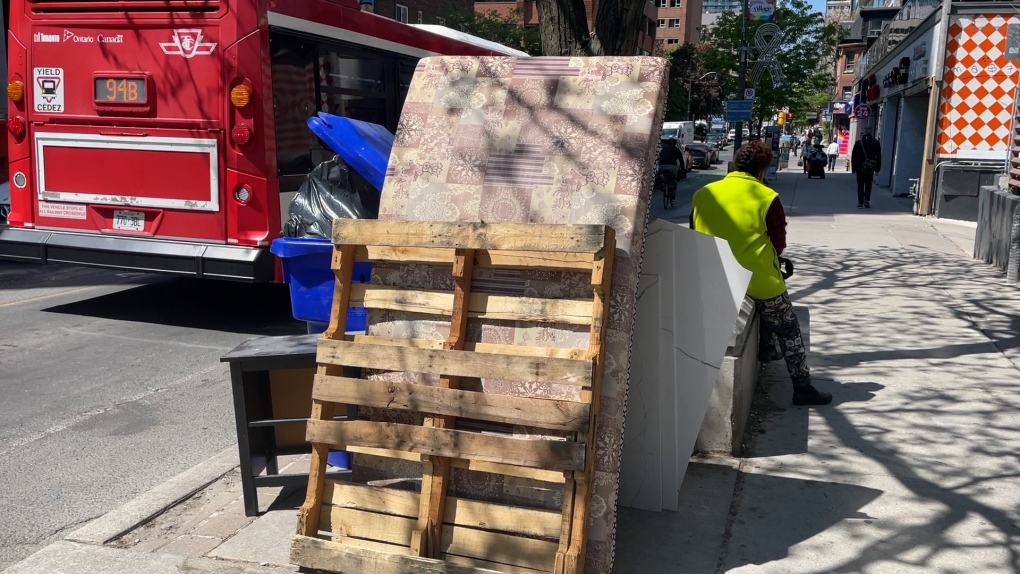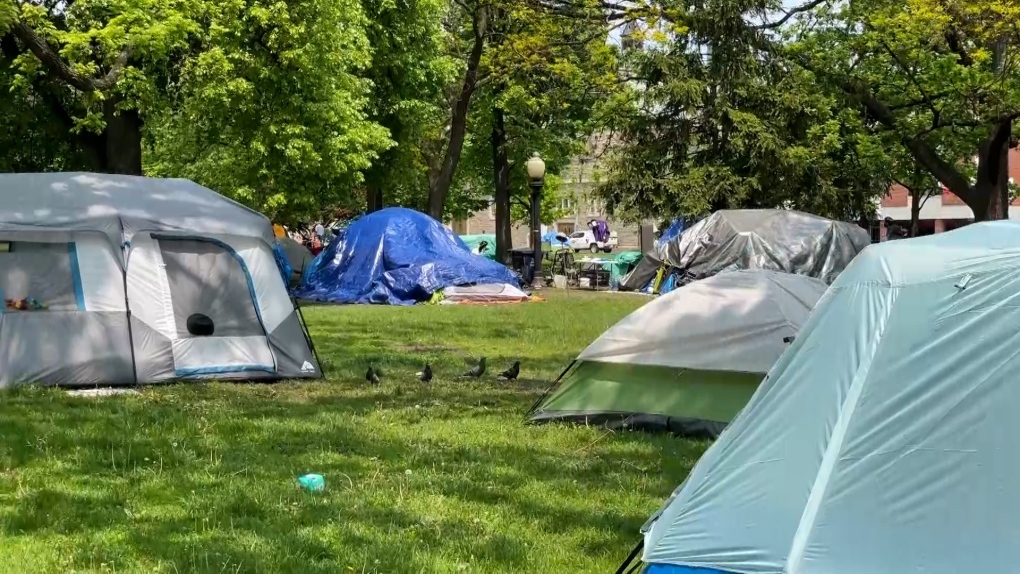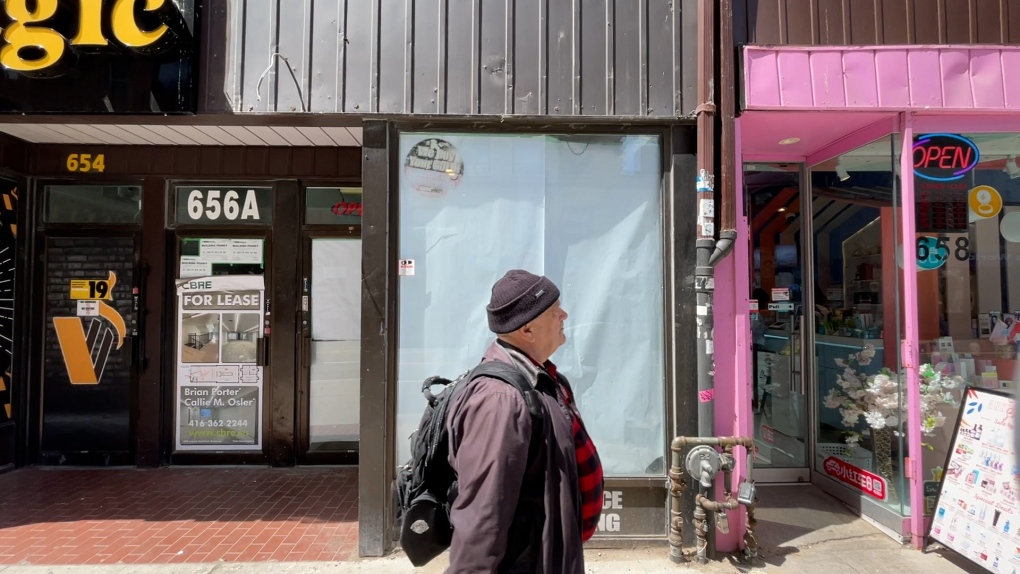'It's getting worse': Years of underinvestment paved way for downtown Toronto decline even before pandemic hit, experts say
In Part 1 of its Downtown Decay series, CTV News Toronto asks: Is the city’s core coming apart at the seams, and how did it get to this point?
As a tourist shuffles his hard-shell luggage along downtown Yonge Street, a man shouting at passersby from the shelter of an arched overhang calls out after him for cash. The clanging suitcase continues to roll, passing a mattress and broken pallet discarded next to a heaping trash bin — and then is soon forced off the sidewalk altogether where the road is ripped up.
It’s a warm Wednesday in the city’s core, and in the shadows of some of Toronto’s tallest towers there are signs of disrepair and decay in the downtown.
“It’s not as good as it used to be,” said Doug Quackenbush, who has lived at the foot of Yonge Street for 20 years. “It’s getting worse before it gets better.”
- Download our app to get local alerts on your device
- Get the latest local updates right to your inbox
“Way worse,” echoed Kwabena Owusu, who took transit down to the core. “There’s a lot of uncleanliness on the subway here, there’s a lot of weird vibes.”
“Even walking downtown, nothing’s clean.”
The broken construction signs, vandalized storefronts, and toppled trash strewn through the nearby park are but small signs of neglect that many insist represent a bigger-picture problem: a downtown in decline.
And while poorly-coordinated road repairs and rerouted, reduced transit have made the core more complicated and costly to navigate, it’s the affordability crisis that has pushed other downtown-dwellers out.
 An overflowing garbage bin is seen in downtown Toronto.
An overflowing garbage bin is seen in downtown Toronto.
“It’s overpriced,” said Williams Dike, who lives downtown. “And it’s really chasing a lot of people away.”
Out to the suburbs, or worse: onto the street. Toronto council declared homelessness an emergency less than two weeks ago.
“The pandemic really took the air out of the balloon,” Matti Siemiatycki, director of the Infrastructure Institute at the University of Toronto’s School of Cities, told CTV News Toronto. “It also started then to highlight some of the challenges that were underlying, that maybe were papered over by the downtown success.”
Challenges, he said, like years of underinvestment in municipal infrastructure—both capital builds and routine maintenance.
“We’re playing catch-up,” he said. “Many of the sewers and watermains and whatnot are 50 years old, and are starting to break down.”
 A number of tents are seen at an encampment in downtown Toronto.
A number of tents are seen at an encampment in downtown Toronto.
“One of the essential problems of the council in Toronto, and some other large cities, is that they forget the basic reason of having a city,” said Frank Clayton, co-founder of Toronto Metropolitan University’s Centre for Urban Research and Land Development.
“They’re there to provide roads, sewer, water, basic infrastructure, parks, and keep them up, maintain them. People want them maintained.”
The core is now struggling to keep pace with rapid population growth, said incoming Toronto Region Board of Trade president Giles Gherson.
“It’s like wearing a shoe that’s two sizes too small. We’ve grown so fast we haven’t built the infrastructure to accommodate it, so we’re now facing that disconnect between what we have now and what we’re going to be in the number of years.” Gherson said.
Services, meanwhile, have gotten the squeeze as a result of a cash flow that has barely covered the basics. A dozen years of mayoral mandates to keep property tax hikes at or below the rate of inflation has left little room for added investment, said Matt Elliott, publisher of City Hall Watcher.
“The city is saying to itself, let’s take a pay cut every year, let’s not try to keep up with population growth and the increased costs that come from that, let’s instead try to wring a bunch of savings out of the budget every year,” Elliott said.
 A man walks by a vacant storefront in downtown Toronto.
A man walks by a vacant storefront in downtown Toronto.
The result, said some Newstalk 1010 listeners, was a city coming apart at the seams.
“It’s absolutely in a state of decline,” one caller said.
“It’s not at rock bottom,” another said. “But it’s certainly collapsing a little bit.”
In Part 2 of Downtown Decay, CTV News Toronto will analyze the impact of the COVID-19 pandemic on Toronto’s core—and examine what the lingering effects mean for the city moving forward.
CTVNews.ca Top Stories

opinion Tom Mulcair: Prime Minister Justin Trudeau's train wreck of a final act
In his latest column for CTVNews.ca, former NDP leader and political analyst Tom Mulcair puts a spotlight on the 'spectacular failure' of Prime Minister Justin Trudeau's final act on the political stage.
B.C. mayor gets calls from across Canada about 'crazy' plan to recruit doctors
A British Columbia community's "out-of-the-box" plan to ease its family doctor shortage by hiring physicians as city employees is sparking interest from across Canada, says Colwood Mayor Doug Kobayashi.
'There’s no support': Domestic abuse survivor shares difficulties leaving her relationship
An Edmonton woman who tried to flee an abusive relationship ended up back where she started in part due to a lack of shelter space.
opinion King Charles' Christmas: Who's in and who's out this year?
Christmas 2024 is set to be a Christmas like no other for the Royal Family, says royal commentator Afua Hagan. King Charles III has initiated the most important and significant transformation of royal Christmas celebrations in decades.
Baseball Hall of Famer Rickey Henderson dead at 65, reports say
Rickey Henderson, a Baseball Hall of Famer and Major League Baseball’s all-time stolen bases leader, is dead at 65, according to multiple reports.
Arizona third-grader saves choking friend
An Arizona third-grader is being recognized by his local fire department after saving a friend from choking.
Germans mourn the 5 killed and 200 injured in the apparent attack on a Christmas market
Germans on Saturday mourned the victims of an apparent attack in which authorities say a doctor drove into a busy outdoor Christmas market, killing five people, injuring 200 others and shaking the public’s sense of security at what would otherwise be a time of joy.
Blake Lively accuses 'It Ends With Us' director Justin Baldoni of harassment and smear campaign
Blake Lively has accused her 'It Ends With Us' director and co-star Justin Baldoni of sexual harassment on the set of the movie and a subsequent effort to “destroy' her reputation in a legal complaint.
Oysters distributed in B.C., Alberta, Ontario recalled for norovirus contamination
The Canadian Food Inspection Agency has issued a recall due to possible norovirus contamination of certain oysters distributed in British Columbia, Alberta and Ontario.


































